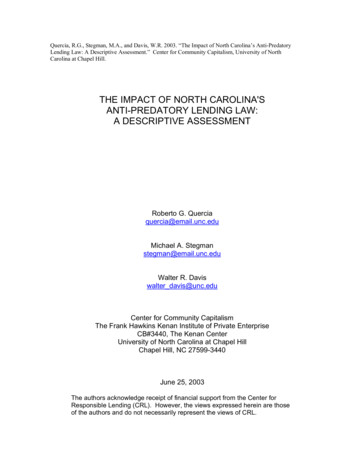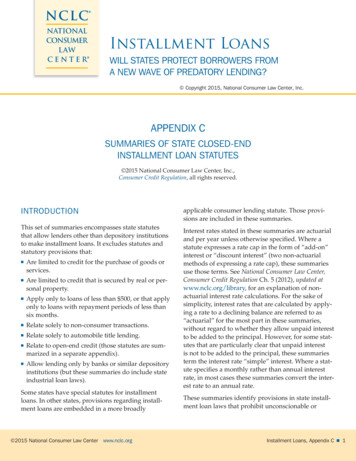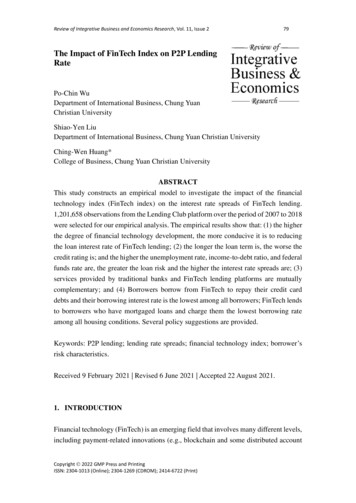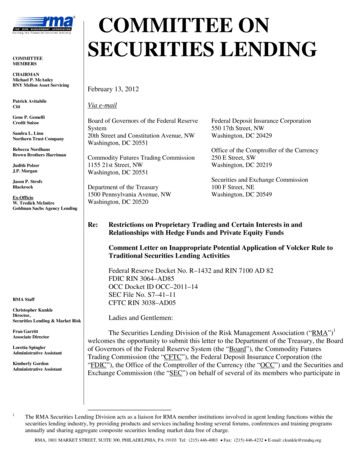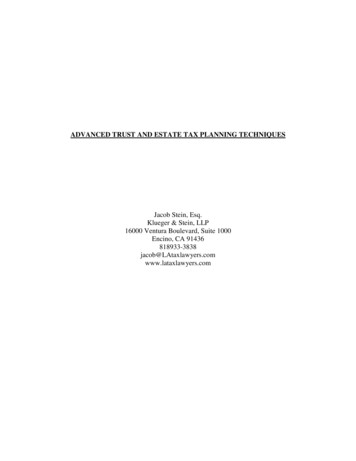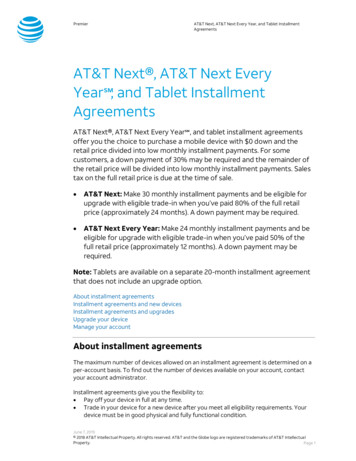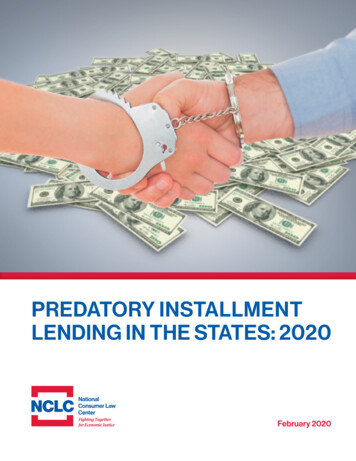
Transcription
PREDATORY INSTALLMENTLENDING IN THE STATES: 2020February 2020
Copyright 2020, National Consumer Law Center, Inc.All rights reserved.ABOUT THE AUTHORABOUT THE NATIONALCONSUMER LAW CENTERSince 1969, the nonprofit NationalConsumer Law Center (NCLC )has used its expertise in consumerlaw and energy policy to work forconsumer justice and economicsecurity for low-income and otherdisadvantaged people, in theUnited States. NCLC’s expertiseincludes policy analysis andadvocacy; consumer law and energypublications; litigation; expertwitness services; and training andadvice for advocates. NCLC workswith nonprofit and legal servicesorganizations, private attorneys,policymakers, and federal and stategovernments and courts across thenation to stop exploitive practices,help financially stressed familiesbuild and retain wealth, and advanceeconomic fairness.Carolyn Carter is the deputy director at National ConsumerLaw Center (NCLC) and has specialized in consumer law issuesfor more than 30 years. Previously, she worked for the LegalAid Society of Cleveland, first as a staff attorney and later aslaw reform director. From 1986 to 1999 she was co-director ofa legal services program in Pennsylvania. She is admitted tothe Pennsylvania bar. From 2005 to 2007 she was a member ofthe Federal Reserve Board’s Consumer Advisory Council. Sheis a graduate of Brown University and Yale Law School. She isa co-author or contributing author of a number of NCLC legaltreatises, including Consumer Credit Regulation and Truth inLending.Lauren Saunders is associate director of NCLC, manages theorganization’s Washington, DC office and directs its federallegislative and regulatory work. Lauren regularly speaks andwrites on high-cost loans, prepaid cards, payment systems, andconsumer protection regulations. She is an author of NCLC’streatise Consumer Banking and Payments Law, among otherpublications. She graduated magna cum laude from HarvardLaw School and was an executive editor of the Harvard LawReview, and holds a Masters in Public Policy from Harvard’sKennedy School of Government and a B.A., Phi Beta Kappa,from Stanford University.Margot Saunders is senior counsel to NCLC. Margot hastestified before Congress on dozens of occasions regardinga wide range of consumer law matters, including predatorylending, payments law, electronic commerce, and other financialcredit issues. She is a co-author of NCLC’s Consumer Bankingand Payments Law and a contributor to numerous other legalmanuals. Margot has often served as an expert witness inconsumer credit cases, providing opinions on predatorylending, electronic benefits, servicing, and credit math issues.She is a graduate of Brandeis University and the University ofNorth Carolina School of Law.ACKNOWLEDGEMENTSThe authors would like to thank Lisa Stifler, director ofstate policy, and Kiran Sidhu, policy counsel, at Centerfor Responsible Lending, for consultation regarding statelegislative developments; Massachusetts attorney Emily GreenCaplan for research; NCLC colleagues Jan Kruse, StephenRouzer, Maggie Eggert, and Anna Kowanko; and Julie Gallagherfor graphic design.NCLC.ORG 2020 National Consumer Law Center
PREDATORY INSTALLMENTLENDING IN THE STATES: 2020TABLE OF CONTENTSEXECUTIVE SUMMARY3Recommendations4INTRODUCTION5WHY THE APR IS THE GOLD STANDARD FOR MEASURING THE COST OF A LOAN6HIGH-COST INSTALLMENT LENDING IN THE STATES: WHERE DO THESTATES STAND NOW?7Significant Changes in the States11KEY RECOMMENDATIONS FOR STATES15What States Should Do to Protect Consumers15ENDNOTES17CHARTSChart 1: APR for 500 Loan With 50 Finance Charge6Chart 2: 2020: Full APRs Allowed for a Six-Month 500 Loan10Chart 3: 2020: Full APRs Allowed for a Two-Year 2,000 Loan11Chart 4: Median State APR Limit by Size of Loan in States that Cap Rates13Chart 5: 500 Six-Month Loan Maximum APR in States with Cap14Chart 6: 2,000 Two-Year Loan Maximum APR in States with Cap14MAPSMap 1:Full APRs Allowed for Six-Month 500 Installment Loan8Map 2: Full APRs Allowed for Two-Year 2000 Installment Loan9TABLESTable:Changes in the States (2018 to 2020) 2020 National Consumer Law CenterNCLC.ORG12Predatory Installment Lending in the States: 20201
This pageintentionally blank
EXECUTIVE SUMMARYCaps on interest rates and loan fees are the primary vehicle by which states protectconsumers from predatory lending. Yet these caps are under attack. In state afterstate, high-cost lenders are mounting campaigns to persuade policymakers to discard or weaken these bulwark protections. This report surveys the battleground asof 2020. It reports on the annual percentage rates (APRs) that the 50 states and theDistrict of Columbia allow nonbank lenders to charge for a sample 500 six-monthloan and a sample 2,000 two-year loan.States have made a number of significant changes since NCLC’s last report on thetopic, Predatory Installment Lending in 2017: States Battle to Restrain High-Cost Loans.California, Colorado, New Mexico, and Ohio improved their laws, imposing APRcaps where none had existed or reducing existing caps. Iowa and Oklahoma went inthe opposite direction, increasing the APRs allowed for installment loans.As a result, as of early 2020, 45 states and the District of Columbia have rate caps fora 500, six-month installment loan. The median rate cap among those that cap ratesis 38.5% APR. Of these jurisdictions, 20 states and the District of Columbia cap theAPR for a 500 six-month loan at 36% or less. Twelve states impose a cap between36% and 60%, and 13 states cap the APR for this loan at more than 60% APR.The lending laws in two states—Delaware and Missouri—do not place any limitwhatsoever on the cost of a 500 six-month loan. Ohio had formerly been in this category until it closed loopholes in 2017 that had allowed lenders to evade its caps. Inaddition, three states—Idaho, Utah, and Wisconsin—do not impose any cap otherthan that the terms of the loan cannot be “unconscionable”—a legal principle thatbans terms that shock the conscience. New Mexico had formerly been in this category, but it imposed a cap—albeit a very high one (175%)—in 2017.As for our sample 2,000 two-year loan, as of early 2020, 42 states and theDistrict of Columbia cap the APR, at a median of 31%. Of those, the great majority—32 states and the District of Columbia—impose a APR of 36% or less. Eight statescap it between 36% and 60% APR, and two states—Illinois and New Mexico—capthe APR for this loan at more than 60%.The lending laws in three states—Delaware, Missouri, and North Dakota—do notplace any cap on the cost of a 2,000 two-year loan. Ohio was in this category untilthe 2017 amendments to its lending laws closed loopholes that had allowed lendersto evade the applicable caps. In addition, five states—Alabama, Idaho, South Carolina, Utah, and Wisconsin—do not impose any cap other than that the terms of theloan cannot be “unconscionable.” New Mexico had formerly been in this category, butsince its 2017 amendments went into effect it has imposed a 175% cap on this loan. 2020 National Consumer Law CenterNCLC.ORGPredatory Installment Lending in the States: 20203
RecommendationsTo protect consumers from high-cost installment loans, states should: Examine consumer lending bills carefully. Predatory lenders often propose billsthat obscure the true interest rate, for example by presenting it as 24% per year plus7/10ths of a percent per day instead of 279%. Or the bill may list the per-month raterather than the annual rate. Get a calculation of the full APR, including all interest, allfees, and all other charges, and reject the bill if it is over 36%.Place clear, loophole-free caps on interest rates for both installment loans andopen-end credit. Rate caps on installment loans will be ineffective if lenders canevade them through open-end lines of credit with low interest rates but high fees.Adopt a tiered rate with caps below 36% for large loans. A maximum APR of 36%is appropriate for smaller loans, such as those of 1,000 or less, but states shouldconsider a lower rate for larger loans.Prohibit loan fees or strictly limit them in order to prevent fees from being used toundermine the interest rate cap and acting as an incentive for loan flipping.Ban the sale of credit insurance and other add-on products, which primarily benefit the lender and increase the cost of credit.In addition, states should make sure that their loan laws address other potentialabuses. States should:4 Require lenders to evaluate the borrower’s ability to repay any credit thatis extended. Prohibit mechanisms, such as security interests in household goods and postdated checks, that coerce repayment of unaffordable loans. Require proportionate rebates of all up-front loan charges when loans are refinanced or paid off early. Limit balloon payments, interest-only payments, and excessively long loan terms.An outer limit of 24 months for a loan of 1,000 or less and 12 months for a loan of 500 or less might be appropriate, with shorter terms for higher-rate loans. Employ robust licensing and reporting requirements, including default and late payment rates, for lenders. Include strong enforcement mechanisms. Make unlicensed or unlawful loans voidand uncollectable and provide a private right of action with attorneys’ fees. Minimize differences between state installment loan laws and state open-end creditlaws so that high-cost lenders do not simply transform their products into openend credit. Tighten up other lending laws, including credit services organization laws, to prevent evasions.Predatory Installment Lending in the States: 2020NCLC.ORG 2020 National Consumer Law Center
INTRODUCTIONCaps on interest rates and loan fees are the primary vehicle by which states protectconsumers from predatory lending. Yet these caps are under attack. In state afterstate, high-cost lenders are mounting campaigns to persuade policymakers to discard or weaken these bulwark protections.This report surveys the battleground as of 2020. It reports on the annual percentagerates (APRs) that the 50 states and the District of Columbia allow nonbank lendersto charge for a sample 500 six-month loan and a sample 2,000 two-year loan.States vary greatly in the level of protection they provide for their residents, with somelimiting APRs to reasonable, affordable levels but others allowing triple-digit APRsor imposing no cap at all. States have made a number of significant changes sinceNCLC’s last report on the topic, Predatory Installment Lending in 2017: States Battle toRestrain High-Cost Loans.1In addition to limiting the cost of the loan for the borrower, limits on finance chargesencourage lenders to ensure that the borrower has the ability to repay the loan.Excessive interest rates enable lenders to profit from loans even if many borrowerseventually default.2 Knowing that it will be made whole even if the borrower defaults,or that it can recoup defaults from exorbitant rates on others, the lender has littleincentive to ensure that each borrower can actually afford to repay the loan in full onits terms.High-cost loans are disproportionately concentrated among borrowers of color.3These loans not only strip financial resources from borrowers and snare them in adebt trap, but the financial stress they cause is also associated with poorer health.4This report is the fourth in our series of reports on installment lending in the states: A Larger and Longer Debt Trap?: Analysis of States’ APR Caps for a 10,000 FiveYear Installment Loan (Oct. 2018) Predatory Installment Lending in 2017: States Battle to Restrain High-Cost Loans(Aug. 2017) Installment Loans: Will States Protect Borrowers from a New Wave of Predatory Lending? (July 2015)This report updates the information about APR caps for the 500 and 2,000closed-end loans but not for the open-end loans or the 10,000 closed-end loan previously analyzed. Our previous calculations for those loans remain largely accuratethough some states have made changes. 2020 National Consumer Law CenterNCLC.ORGPredatory Installment Lending in the States: 20205
WHY THE APR IS THE GOLD STANDARD FOR MEASURINGTHE COST OF A LOANThe APR is the gold standard for measuring the true cost of a loan. The APR providesa common, apples-to-apples comparison of the cost of two different loans, evenwhen used to borrow different amounts for different periods of time, and accounts forthe possibility of rollovers.The APR is an accuratemeasuring stick of thecost of a loan because itincludes both interest andloan fees, and takes intoaccount the amount oftime the borrower has torepay the loan.One reason that the APR is an accurate measuring stick is that itincludes not just periodic interest but also loan fees. In many cases,the fees dwarf the interest, so focusing just on the interest rategives an entirely misleading impression of the cost of the loan.In addition, the APR takes into account the amount of time that theborrower has to pay back the loan. For example, if the interest andfees for a 500 loan come to 50, the APR is 36% if the borrowercan pay it back with payments twice a month for 6 months, but240% if the whole 550 is due in 15 days. Obviously, repayment willbe much more burdensome to the borrower if it is due in 15 days.And, if the 15-day loan is rolled over 12 times, with the borrower paying just the 50 feetwice a month and then repaying the amount borrowed with the twelfth payment—acommon pattern with payday loans—that 240% APR means that the borrower willpay 600 in finance charges for the 500 loan.CHART 1APR for 500 Loan With 50 Finance ChargePayments twice a month for 6 months36%APR240%APRPayable with single payment after 15 days6Predatory Installment Lending in the States: 2020NCLC.ORG 2020 National Consumer Law Center
In order to obscure the true cost of the loan, predatory lenders like to focus borrowers’ attention on just the interest rate, or on the finance charge per 100, withouttaking the length of time to repay into account.The APRs that the federal Truth in Lending Act5 requires lenders to disclose forinstallment loans, like those in this report, also take both interest and fees intoaccount.6 (The Truth in Lending Act creates some loopholes for certain types offees, but the loopholes are not generally relevant to the unsecured installment loansaddressed in this report.)7The Military Lending Act, which limits the APR to 36% for most credit extended toactive-duty servicemembers and their families, takes an even more all-inclusiveapproach to the APR. It requires the calculation to include the cost of products likecredit insurance that are added to the loan.8 This report’s calculations are based onthe assumption that the lender has not charged the borrower for credit insurance, sothe calculation of the APRs in this report is consistent with both the Truth in LendingAct and the Military Lending Act for the two sample loans.HIGH-COST INSTALLMENT LENDING IN THE STATES:WHERE DO THE STATES STAND NOW?Most states currently cap interest rates and loan fees (fees imposed as a conditionof the extension of credit) for closed-end 9 consumer installment loans. However, thecaps vary greatly from state to state, and a few states do not cap interest rates at all.States also vary considerably in the caps they impose for open-end credit such ascredit cards. (See NCLC’s 201710 and 201511 reports.) 500 six-month loan: As of early 2020, 45 states and the District of Columbia haverate caps for a 500, six-month installment loan (see chart on page 10). The medianrate cap among those that cap rates is 38.5% APR. Of these jurisdictions, 20 statesand the District of Columbia cap the APR for a 500 six-month loan at 36% or less.Twelve states impose a cap between 36% and 60%, and 13 states cap the APR forthis loan at more than 60% APR.The lending laws in two states—Delaware and Missouri—do not place any limitwhatsoever on the cost of a 500 six-month loan. Ohio had formerly been in this category, but in 2017 it closed loopholes that had allowed lenders to evade its caps. Inaddition, three states—Idaho, Utah, and Wisconsin—do not impose any cap otherthan that the terms of the loan cannot be “unconscionable”—a legal principle thatbans terms that shock the conscience. New Mexico had formerly been in this category, but it imposed a cap—albeit a very high one (175%)—in 2017. 2020 National Consumer Law CenterNCLC.ORGPredatory Installment Lending in the States: 20207
MAP 1Full APRs Allowed for Six-Month 500 Installment LoanWA39%MT36%ME30%ND28%MN51%OR36%IDno cap*WY36%NV40%UTno cap*CA45%AZ54%WIno NM175%MOno atory Installment Lending in the States: 2020NCLC.ORG 2020 National Consumer Law CenterVT24% NH36%MA 37%NJ30%RI 35%CT 36%DE no capMD 33%DC 27%
MAP 2Full APRs Allowed for Two-Year 2,000 Installment LoanWA29%MT36%ME30%NDno capMN31%OR36%IDno cap*WY31%NV40%UTno cap*CA25%AZ41%WIno cap*SD36%MI30%IA36%NE30%CO31%NY25%IL80%KS32%MOno capOK27%NM175%OH37%IN39%WV33%KY42%AR17%ALno cap*VA36%MA 24%NJ30%RI 29%CT 36%DE no capMD 30%DC 25%NC31%TN41%MS59%TX35%PA24%VT21% NH36%SCno cap*GA32%LA38%FL31%AK31%HI31% 2020 National Consumer Law CenterNCLC.ORGPredatory Installment Lending in the States: 20209
CHART 22020: Full APRs Allowed for a Six-Month 500 LoanNo capNo cap exceptunconscionabilityNo stated cap on finance charges(2 states: DE, MO)No numerical cap, but prohibitsunconscionability (3 states: ID, UT, WI)36%or lessOver60%Allowable full APR over 60% (13 states:AL, CO, GA, IL, IN, LA, MS, NM, OH, OK,SC, TN, TX)Allowable full APR between 36% and60% (12 states: AZ, CA, FL, KS, KY, MA,MI, MN, NE, NV, WA, WV)36%to 60%Allowable full APR of 36% or less(21 states: AK, AR, CT, DC, HI, IA, ME,MD, MT, NH, NJ, NY, NC, ND, OR, PA, RI,SD, VT, VA, WY) 2,000 two-year loan: As of early 2020, 42 states and the District of Columbia capthe APR on a 2,000, two-year installment loan, at a median of 31%. Of these, thegreat majority—32 states and the District of Columbia—cap the APR for this loan at36% or less. Eight states cap it between 36% and 60% APR, and two states—Illinoisand New Mexico—cap the APR for this loan at more than 60%.The lending laws in three states—Delaware, Missouri, and North Dakota—do notplace any cap on the cost of a 2,000 two-year loan. Ohio had been in this categoryuntil the 2017 amendments to its lending laws closed loopholes that had allowed lenders to evade the applicable cap. In addition, five states—Alabama, Idaho, South Carolina, Utah, and Wisconsin—do not impose any cap other than that the terms of theloan cannot be “unconscionable.” New Mexico had formerly been in this category, butsince its 2017 amendments went into effect it has imposed a 175% cap on this loan.10Predatory Installment Lending in the States: 2020NCLC.ORG 2020 National Consumer Law Center
CHART 32020: Full APRs Allowed for a Two-Year 2,000 LoanNo cap exceptunconscionabilityNocapOver60%No stated cap on finance charges(3 states: DE, MO, ND)No numerical cap, but prohibitsunconscionability (5 states: AL, ID,SC, UT, WI)Allowable full APR over 60%(2 states: IL, NM)36%to 60%Allowable full APR between 36% and60% (8 states: AZ, IN, KY, LA, MS, NV,OH, TN)36%or lessAllowable full APR of 36% or less(33 states: AK, AR, CA, CO, CT, DC,FL, GA, HI, IA, KS, ME, MD, MA, MI,MN, MT, NE, NH, NJ, NY, NC, OK, OR,PA, RI, SD, TX, VT, VA, WA, WV, WY)Significant Changes in the StatesSince NCLC’s 2017 update, three states have imposed APR caps on a wide range ofloans that formerly were not capped. Until statutory amendments went into effect onJanuary 1, 2020, California’s consumer lending laws capped APRs only for loans of 2,500 or less. As a result, high-cost lenders steered consumers into loans just a bitabove 2,500, and often charged APRs well over 100%.12 As of January 1, 2020, forloans over 2,500 the interest rate is capped at 36% plus the Federal Funds Rate,13which is currently about 1.5%.14 The law also allows the lender to charge a 75 upfront fee. For a two-year loan of 2,600, the result is an APR of about 41%—still high,but a great improvement for consumers. Since the maps and pie charts in this reportdeal just with loans of 500 and 2,000, they do not reflect the impact of the new law,which prevents a lender from evading the cap for a 2,000 loan by persuading theborrower to accept a 2,600 loan.New Mexico formerly did not cap the APRs for consumer loans at all. In 2017, thestate imposed a 175% APR cap on consumer loans of 5,000 or less, effective January 1, 2018.15 This cap still allows abusively high loans—loans that consumers areunlikely to be able to repay, and that operate as long-term debt traps—but it represents a step in the right direction. 2020 National Consumer Law CenterNCLC.ORGPredatory Installment Lending in the States: 202011
TABLEChanges in the States (2018 to 2020)20182020States that ImprovedCaliforniaDid not cap APRs for loans over 2,500Caps APRs for larger loans; APR forloan of 2,600 is capped at 41%ColoradoAllowed 180% APR for 500 paydayinstallment loanCaps the APR for payday installmentloans at 36% (but still allows APR of90% under a different law)New MexicoDid not cap APRsCaps APRs for consumer loans of 5,000 or less at 175%OhioLoopholes enabled lenders toevade capsCloses loopholes, although still allowsvery high rates for loans of 1,000or lessIowaLimited APR for 2,000 two-year loanto 31%Allows 36% APR for 2,000two-year loanOklahomaAllowed 108% APR for 500six-month loanAllows 204% APR for 500six-month loanStates that RegressedOhio has struggled for over 10 years to bring high-cost lending under control. In2008, the state legislature repealed a law that allowed high-cost short-term lending and replaced it with one that capped the APR for loans of 500 or less at 28%.The state’s voters then overwhelmingly rejected a ballot initiative pushed by highcost lenders that would have restored the original law.16 But then high-cost lendersdevised evasions—they started making payday loans under a state mortgage lendinglaw, and also worked through credit services organizations, which charged sky-highfees for arranging loans that purported to charge interest at a low rate. In 2017, thestate legislature overhauled the state’s consumer lending laws17 and closed theseloopholes for the loan sizes analyzed in this report. However, the revised laws stillallow very high-cost lending. For a 500 six-month loan a lender can charge an APRof 145%, though for a 2,000 two-year loan the allowable APR drops to 37%.In contrast to the three states that have capped uncapped APRs, two other statesmoved in the opposite direction, revising their lending laws in ways that increase theallowable APRs for a 2,000 two-year loan or a 500 six-month loan. Iowa revised aregulation under its Regulated Loan Act in mid-2017 to allow a lender to charge 36%on the first 3,000 of the loan amount, instead of just the first 1,000.18 As a result ofthis change, a lender can now charge an APR of 36% for a 2,000 two-year loan—up from 31%.12Predatory Installment Lending in the States: 2020NCLC.ORG 2020 National Consumer Law Center
Oklahoma’s change was far more serious: in 2019, it enacted the Oklahoma SmallLenders Act.19 It allows a lender to charge 17% per month on a loan up to 1,500 thatis payable over up to 12 months. This produces a jaw-dropping APR of 204% for a 500,six-month loan. Even before this predator-friendly law was enacted, Oklahoma allowedan APR of 108% for this loan. While this new law was part of a package that phases outthe state’s payday loan law,20 it allows high-cost loans to be three times larger and eighttimes longer than the former payday loans, creating a larger and longer debt trap.One other change is important to note. In 2018, Colorado voters overwhelminglyapproved a ballot initiative that caps the APR at 36% for payday installment loans upto 500 that are made under the state’s Deferred Deposit Loan Act.21 The state’sother lending laws still allow an APR of 90% for a 500 six-month loan—which is therate we have included in this report—but this is a significant improvement over theformer law, which allowed APRs of 180% or more.22CHART 4Median State APR Limit by Size of Loan in States that Cap Rates40%30%38.5%31%25%20%10%0% 5006-month Loan 2,0002-year Loan 10,0005-year Loan**Median APR for 10,000 5-year loan is based on 2018 calculations. 2020 National Consumer Law CenterNCLC.ORGPredatory Installment Lending in the States: 202013
KSMICAKYFLNEMNAZGAINSCLACOTXALTNILOHNMOKMSCHART 5CHART 6 500 Six-Month LoanMaximum APR in States with Cap(45 states plus DC) 2,000 Two-Year LoanMaximum APR in States with Cap(42 states plus %36%36%36%36%36%37%38%—Median 30%30%30%31%31%31%—Median %38%39%40%41%41%42%59%80%No cap except unconscionability: AL, ID, SC, UT, WINo cap: DE, MO, NDNo cap except unconscionability: ID, UT, WINo cap: DE, MO14175%Rates arePredatoryfor closed-endloans.RateswillStates:differ2020for lines ofcredit and other open-endcredit.NCLC.ORGInstallmentLendingin the 2020 NationalConsumer Law Center
KEY RECOMMENDATIONS FOR STATESStates’ protections against predatory installment loans continue to be under attack.Consumers, state policymakers, and advocates should remain vigilant to predatorylenders’ attempts to bring high-cost lending to their states, especially for longer-termloans that, despite slightly lower APRs, can be an even bigger, deeper debt trap thantraditional short-term payday loans.The most important aspect of state loan laws is the cap they place on interest ratesand fees. As NCLC’s survey reveals, many states lower the rate cap as the size of theloan gets bigger. That only makes sense. The bigger the loan, the more interest thatwill be charged, and usually loan terms are longer too, so that interest will be paidover a longer period of time. Many states have tiered rate caps, which are reflected inthe median rates among the states with caps: 38.5% APR for a 500, six-month loanand 31% APR for a 2,000 two-year loan. Similarly, our 2018 calculations showed amedian APR of 25% for a 10,000, five-year loan.23What States Should Do to Protect ConsumersStates should: Examine consumer lending bills carefully. Predatory lenders often propose billsthat obscure the true interest rate, for example by presenting it as 24% per year plus7/10ths of a percent per day instead of 279%. Or the bill may list the per-month raterather than the annual rate. Get a calculation of the full APR, including all interest, allfees, and all other charges, and reject the bill if it is over 36%.Place clear, loophole-free caps on interest rates for bothinstallment loans and open-end credit. Rate caps on installmentloans will be ineffective if lenders can evade them through openend lines of credit with low interest rates but high fees.Adopt a tiered rate with caps below 36% for large loans. Amaximum APR of 36% is appropriate for smaller loans, such asthose of 1,000 or less, but states should consider a lower ratefor larger loans.Prohibit loan fees or strictly limit them in order to prevent feesfrom being used to undermine the interest rate cap and acting asan incentive for loan flipping.States should place clear,loophole-free caps oninterest rates for bothinstallment loans andopen-end credit. Amaximum APR of 36% isappropriate for smallerloans, with a lower rate forlarger loans.Ban the sale of credit insurance and other add-on products, which primarily benefit the lender and increase the cost of credit.24 2020 National Consumer Law CenterNCLC.ORGPredatory Installment Lending in the States: 202015
In addition, states should make sure that their loan laws address other potentialabuses. States should: Require lenders to evaluate the borrower’s ability to repay any credit thatis extended. Prohibit mechanisms, such as security interests in household goods and postdated checks, that coerce repayment of unaffordable loans. Require proportionate rebates of all up-front loan charges when loans are refinanced or paid off early. Limit balloon payments, interest-only payments, and excessively long loan terms.An outer limit of 24 months for a loan of 1,000 or less and 12 months for a loan of 500 or less might be appropriate, with shorter terms for higher-rate loans. Employ robust licensing and reporting requirements, including default and late payment rates, for lenders. Include strong enforcement mechanisms. Make unlicensed or unlawful loans void anduncollectable and provide a private right of action with attorney fees. Minimize differences between state installment loan laws and state open-end creditlaws so that high-cost lenders do not simply transform their products into openend credit. Tighten up other lending laws, including credit services organization laws, to prevent evasions.NCLC’s 2015 report25 has more details on each of these recommendations.In the absence of rate limits at the federal level, state interest and fee caps are theprimary bulwark against predatory lending. By following these guidelines, states canensure that their laws are effective at protecting consumers.16Predatory Installment Lending in the States: 2020NCLC.ORG 2020 National Consumer Law Center
ENDNOTES1. National Consumer Law Center, Predatory Installment Lending in 2017: States Battle to RestrainHigh-Cost Loans (Aug. 2017).2. National Consumer Law Center, Misaligned Incentives: Why High-Rate Installment Lenders WantBorrowers Who Will Default (July 2016).3.
As a result, as of early 2020, 45 states and the District of Columbia have rate caps for a 500, six-month installment loan. The median rate cap among those that cap rates is 38.5% APR. Of these jurisdictions, 20 states and the District of Columbia cap the APR for a 500 six-month loan at 36% or less. Twelve states impose a cap between


